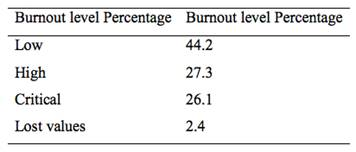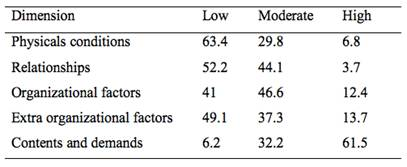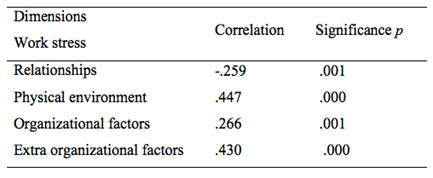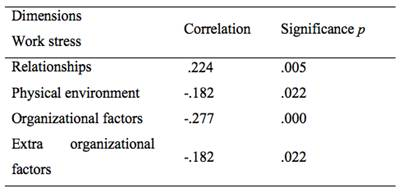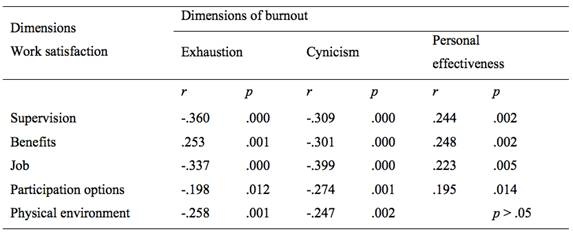Services on Demand
Journal
Article
Related links
Share
Ciencias Psicológicas
Print version ISSN 1688-4094On-line version ISSN 1688-4221
Cienc. Psicol. vol.12 no.2 Montevideo Nov. 2018
https://doi.org/10.22235/cp.v12i2.1688
Original Articles
The relation between work stress and burnout syndrome in a sample of Chilean air traffic controllers
1Facultad de Psicología, Universidad Católica del Uruguay andrea.aguirre@ucu.edu.uy,mgallodv@gmail.com, ibarralexander@gmail
2Facultad de Psicología Universidad de Salamanca. España, jsanchez@usal.es Correspondence: Carla Aguirre Mas. Instituto de Bienestar, Facultad de Psicología, Univ. Católica del Uruguay
Key words: work stress; burnout; work satisfaction; work-family conflict; air traffic controllers
Palabras Claves: estrés laboral; burnout; satisfacción laboral; conflicto trabajo-familia; controladores de tráfico aéreo
Introduction
According to Jiménez and Moyano (2008), there is a strong consensus in the social sciences that work is one of the most important activities for the integration and psychological and social adjustment of individuals. Work is necessity for people, because it allows obtaining goods -directly or indirectly- and achieving satisfactory personal or social compensations. Socially, work can be considered as a duty to participate in the efforts of a group, in order to contribute to the development of society (Moyano & Ramos, 2007). Thus, work has been transcending over the years from the sphere of the economy -obtaining goods- to other relevant aspects of people's lives -satisfaction and quality of life-, generating changes in the ways of working and new social values. Due to this, companies are interested in generating techniques that allow them to meet personal needs and promote the well-being of workers, generating new policies to improve the conditions for the performance of their workers (Dirección General del Trabajo, 2018).
Peiro and Rodríguez (2008) point out that demographic changes, new markets and new technologies have generated a large number of indicators of absenteeism, job dissatisfaction, work accidents, poor performance and work stress accompanied by burnout.
According to Aguirre (2015) for samples of commercial aircraft pilots, it is possible to conceptualize five potential sources of stress in the work context:
1. Physical conditions of the workplace: conditions specific to the design and structure of the workplace, such as ventilation, noise, lighting, temperature, layout of the physical work space, rest spaces, hygiene, among others.
2. Interpersonal relationships: relationships and contacts established with other people in the workplace as hierarchies, peers of the same or lower hierarchy and relationship with the users of the services.
3. Organizational factors: the system of rules that regulate the interactions and behaviors of the individual at work such as policies, schedule regulations and conditions for benefits.
4. Contents and demands of the work: like excessive duration of the work, complexity of the tasks, incapacity to develop abilities and the systems of turns.
5. Work-family conflict or extra organizational factors: which are all those factors of personal life that can potentially be harmed by work if they do not interact with it in a healthy way for the worker; as, for example: the possibility of being with your family. It has been identified as a stressor with influence on working life, faced with difficulties in balancing the responsibilities of the work and family spheres
In relation to this, work stress has been studied and different explanatory models have been proposed, since various social conditions can act as stressors and modify the health of people (Peiro & Rodríguez, 2008; Sadin, 2003). Likewise, the effects on stress triggers have been studied, which are not only limited to socio demographic variables such as age, income level, gender, among others (Kanner et al., 1981; Fernández & Piñol, 2000), but include other daily variables where the worker experiences negative experiences associated with the work context.
Repeated periods of stress usually precede the burnout syndrome, translated as burn by work, which results from the interaction of variables in the work and personal environment, alluding to a series of symptoms and feelings associated with work stress. These symptoms are characterized by emotional exhaustion, lack of energy, distancing and cynicism towards the recipients, feelings of incompetence, deterioration of professional self-concept, and attitudes of rejection towards work (Gil-Monte & Peiró, 1999; Jiménez & Moyano, 2008; Olmedo et al., 2001). Other diverse psychological symptoms such as irritability, anxiety, sadness and low self-esteem and work dissatisfaction (Moriana, 2006) and physical symptoms such as respiratory diseases and allergies (Fu, Lindgren, Wieslander, Janson, & Norbäck, 2016).
Maslach and Jackson (1986) proposed three dimensions of burnout:
- Emotional exhaustion: are the sensations of physical exertion and emotional boredom that occur because of the continuous interactions that workers must maintain among them.
- Cynicism or depersonalization: involves the development of cynical attitudes and responses towards the people to whom the workers provide their services, accompanied by an increase in irritability, where the worker distances himself from the people with whom he works and the users of the services, trying to make them guilty of their frustrations and work problems.
- Low personal efficiency: loss of confidence in personal fulfillment and the presence of a negative self-concept as a result of unpleasant situations.
Feeling lack of competence, effort or knowledge, lack of expectations, work horizons and widespread dissatisfaction. Given as consequence: unpunctuality, abundance of interruptions, and avoidance of work, absenteeism and abandonment of the profession.
Work stress and burnout not only trigger problems in the field of mental / physical health, of individuals / family, but also have economic repercussions for organizations. A relationship has been found between absenteeism, rotations and work productivity with preventable health problems related to work stress (Guic, Bilbao, & Bertin, 2002).
Job satisfaction refers to the quality of working life in relation to organizational commitment and elements of work such as environmental conditions, salary, job security, promotion possibilities and tasks performed (Segurado & Argullo, 2002).
Sánchez and Quiroga (1995) studied three types of couples: traditional, with double income and with double career. They found greater satisfaction in single workers with a higher educational level. Also in women, the congruence between both worlds predominates: there is satisfaction or dissatisfaction in both; whereas in men the incongruity is more frequent: there is satisfaction in one environment and not in the other.
When assessing risks, aeronautical professionals occupy the third place worldwide among professions with greater exposure to stress, due to the physical exposure of: musculoskeletal conditions, hearing, among others or psychological demands: anxiety, depression, suicidal ideation, among others (Aguirre et al., 2015; Wu et al., 2016).
The air traffic controllers (CTA) in Chile are the personnel in charge of directing the transit of aircraft in the airspace. Also, maintaining the airports in a safe, orderly and fast manner, authorizing the pilots of the aircraft with instructions and providing information within the airspace under their responsibility, in order to prevent collisions between aircraft and obstacles in the maneuvering area of aerodromes and airports. Their work is critical since they are in charge of the lives of several people who travel on each flight, also worrying about possible meteorological changes and other unforeseen events. All this generates constant tension, in addition to working in the least appropriate conditions with exposure to noise, heat, among other factors (Miranda, 2008).
The present research aims to identify if there is a relationship between work stress and the perception of burnout, with the possible implications that these links imply for the quality of life of the CTAs of Chile.
Method
Procedure
The study was transversal, with burnout, work stressors and job satisfaction in traffic controllers as study variables. It was also included: marital status, age, sex, the presence of children, employment and the type of contract. Single sample measurements have been used with a response rate of 10% of the total CTAs contacted. The univariate and bivariate descriptive statistics was calculated using the statistical program SPSS 22.0. It is highlighted that for the data collection, the participants were asked to sign informed consent in each scale and the approval of the research was given in the framework of the review of the Ethics Committee of the Faculty of Psychology of the University of Salamanca, Spain.
Participants
The sample consisted of 161 CTAs between 30 to 64 years of age. The sampling technique was non-probabilistic and for convenience. The following table collects the socio demographic data characteristic of the sample. Table 1
Instruments
Questionnaire (A) MBI-GS (Schaufeli, Leiter, Maslach, & Jackson, 1996). This instrument evaluates burnout; it is composed of 15 separate items in 3 dimensions: exhaustion, depersonalization and personal efficacy. The items propose affirmations of the personal attitudes and emotions of the controllers about their performance and their work in general, which are answered in the form of a Likert scale of 6 points that goes from never (1) to always (6). The reliability of the entire burnout scale in this CTA sample, measured by the Cronbach alpha coefficient of internal consistency, is adequate (α = .849).
Instrument for measuring Work Stress detonators for pilots (IMDELP) (Aguirre et al., 2015). Evaluates the five dimensions of stressors described in the theory: physical conditions, interpersonal relationships, organizational factors, extra organizational factors, content, and demands of work. Although it is an instrument created to evaluate work stress triggers in pilots of commercial aircraft, it was proposed to adapt the items to the characteristics of the sample. The answers were collected from a 5-point likert scale, ranging from (1) "strongly disagree" to (5) "strongly agree". The reliability of the scale was estimated by means of the internal consistency coefficient of Cronbach's alpha, in the CTA sample it was an α equal to .927.
Job satisfaction (Aguirre et al., 2015). Composed of 20 items with affirmative phrases adapted to the characteristics of the sample, with five alternative answers on a 5-point lickert scale ranging from "very dissatisfied" (1) to “very satisfied "(5). This scale is composed of dimensions: satisfaction with supervision, with work, with the physical environment, with benefits, and with opportunities for participation.
Perception of performance (Aguirre et al., 2015). It is a one-dimensional scale of 2 items, constructed and validated by Aguirre (2006) and adapted to the characteristics of the present sample. The response format is a 5-point Likert scale that ranges from "strongly agree" (1) to "strongly disagree" (5).
Psychosomatic symptoms of stress (Aguirre et al., 2015). To make an assessment of the physiological activation of stress responses, a questionnaire validated in previous studies was used for samples of commercial aircraft pilots (Aguirre, 2015), which were adapted to the items according to the characteristics of this sample. It consists of ten items with affirmative phrases relating to the individual's perception of stress symptoms. Such items should be answered with a single response alternative on a 5-point Likert scale, ranging from "strongly agree" (1) to "strongly disagree" (5).
Questionnaire (C) Family Work Conflict, developed by Carlson, Kacmar and Williams (2000), it is used to measure types of work-family conflict based on stress, behavior and time, and has two directions in which gives work conflict to family and family to work, with a reliability of .927. The scale is likert type from 1 to 5 with 18 affirmations.
The cohort points were made through confidence intervals, which were distributed as follows a) High, b) Low, c) Critical, technique designed by Vauro (2014) and Aguirre (2015), for the projection of these values, they had as source, the median of each interval.
Results
Regarding burnout levels, a low level prevails, followed by a high degree of affectation and by critical levels (Table 2). This last category is related to high levels of risk to experience physical and psychological symptomatology related to burnout.
Regarding the dimensions of the MBI-GS Burnout scale, it can be seen in Table 3 that personal efficacy is the one with the highest levels, followed by emotional exhaustion and at lower levels cynicism.
Regarding the levels of work stress, the highest level was found in the content and work demands dimension, followed by the extra organizational factors. The controllers reported the physical conditions of work and the interpersonal climate as less stressful (Table 4).
The controllers reported better satisfaction with their work and supervision. While benefits such as salary, and other remuneration, participation options and the physical environment are the ones with the least degree of satisfaction (Table 5).
Regarding the perceived work performance, only 3.1% of the sample considers that their performance in the work context is low; 16.8% perceive it at a moderate level and 80.1% report having a high work performance.
In relation to the dimension psychosomatic symptoms of stress, 88.2% of the sample presents a low perception of stress; 10.6% manifest a moderate perception of stress, and only 1.2% perceives beings stressed.
Table 6 shows the level of work-family conflict based on its dimensions and the two directions in which it occurs: work conflict towards family and family to work. In general, they reported moderate levels of conflict in the stress associated with each role, in behaviors and in temporal demands, as well as with the degree of work interference in family dynamics.
Significant differences were found in the exhaustion dimension according to the age range (F = 2.989, p = .021). Air traffic controllers in the age range of 53 to 63 years reported a lower degree of exhaustion than those under 53 or greater than 63 (F = 4.408, p = .044). No differences were found in cynicism or in personal efficacy according to age (p > .05).
Significant differences were also found according to sex: women tend to perceive more exhaustion than men (F = 4.408, p = .044). These differences were not found according to sex in the dimensions cynicism and personal efficacy (p > .05).
Regarding the marital status, the presence or absence of children and the type of employment contract, they did not have a significant relationship with any of the dimensions of burnout, but the work permanence variable did, although only with the depletion dimension, resulting statistically significant (F = 2.934, p = .019). While all the air traffic controllers reported perceiving low levels of exhaustion, those with 5 years of work experience score highest in the exhaustion dimension.
If they found statistically significant differences (p <.05) according to age in three dimensions of work stress: in physical conditions, in extra organizational factors and in contents and demands. The controllers of the age group of 64 years report lower stress than the rest of the groups, in relation to physical conditions and extra organizational factors. While the group aged between 53 and 63 reported a lower level of stress related to content and demands.
The drivers of the marital status group "widowers" scored higher when identifying the contents and demands of work as moderate stressors, in comparison with the rest of the groups, who scored low stress level (p <.05). No differences were found according to marital status, in the rest of the work stress dimensions.
Drivers without children identify more work stress related to the physical environment, although both these and those with children do not perceive that the physical environment is a significant trigger (p > .05). No differences were found in the rest of the dimensions of work stress according to the presence or not of children.
The group of controllers with a fixed contract identified more stress in relation to the physical environment, in comparison with the temporary contract (F = 4.630, p = .033); although both groups place low level of stress related to this factor. No statistically significant differences were found according to the type of contract, in the rest of the dimensions of work stress.
Controllers with more working time score lower than those with shorter work time in the identification of contents and work demands as stressors (F = 2,523, p = .043); although all identify low level of stress related to this factor. No statistically significant differences were found in the rest of the dimensions of work stress, according to the work permanence.
Regarding the relationship between job satisfaction and age, only the group with the highest age (= 64) scored higher in all satisfaction dimensions (F = 1.801, p = .131).
Both men and women included in the sample perceive low levels of satisfaction with work, although women have a more favorable perception (p <.05); not so with the dimension satisfaction with the physical environment, in which men score higher (p <.05). No statistically significant differences were found in the rest of satisfaction dimensions according to sex.
Controllers with children have a more favorable perception of the physical environment than those without children (F = 1.801, p = .131). No significant difference was found according to the presence of children with the rest of the satisfaction dimensions.
Statistically significant differences were found according to the length of work with the degree of satisfaction in its different dimensions (p <.05). However, no differences were found in the degree of job satisfaction according to the type of contract or according to marital status (p <.05). No relationship was found between work stress, performance and the socio demographic variables included in the study (p <.05).
On the other hand, it was found that the contents and demands of the work do not have a statistically significant relationship with any of the dimensions of burnout (p > .05).
It was found that the greater the favorable perception of the interpersonal relationships that occur in the work, the perception of exhaustion decreases in the controllers of the sample and vice versa. On the contrary, the exhaustion report increases as occupational stressors related to the physical environment increase, with organizational and extra organizational factors (Table 7)
As the favorable perception of interpersonal relationships at work increases, the perception of cynicism decreases and vice versa. The relationship is positive between cynicism and the physical enviroment, organizational factors and extra organizational factors as triggers of work (Table 8).
By increasing the perception of work stress according to interpersonal relationships, the personal effectiveness report also increases, while the physical environment, organizational factors and extra organizational factors present a negative association with personal efficacy (Table 9).
The greater the exhaustion, the less job satisfaction and vice versa; and to greater cynicism lower work satisfaction and vice versa. The opposite occurs with personal efficacy, the greater the job satisfaction, the greater the personal efficiency and vice versa (Table 10).
The greater the degree of exhaustion and cynicism, the greater the report of psychosomatic stress symptoms (r = .357, p = .000 and r = .257, p = .001 respectively). Conversely, the greater the perception of psychosomatic stress symptoms, the lower the degree of personal efficacy (r = -.163, p = .041).
The lower the level of exhaustion and cynicism, the higher the degree of performance (r = -.282, p = .000 and r = -.233, p = .004 respectively). On the other hand, the greater the perception of performance, the greater the degree of personal efficacy (r = .241, p = .002).
To the extent that the factors of the physical environment are identified as stressful, the perception of conflict between work and family also increases (r = .370, p = .000).
In addition, it was found that insofar as organizational and extra-organizational factors are identified as triggers of stress, the perception of greater work-family conflict also increases (r = .397, p = .000 and r = .604, p = .000, respectively).
On the other hand, the higher the perception of the interpersonal relationships that occur at work, the lower the perception of work-family conflict (r = -.258, p = .001).
Only the factor content and demands of the work is not significantly related to exhaustion (p > 0.05).
Conclusion
Most CTAs perceive critical levels of burnout syndrome, feeling moderately exhausted and generating an emotional distancing between co-workers. This is consistent with the theory, to allude that chronic work stress or burnout, is one of the main sources of psychosocial risk at work (Bausela, 2005, Olmedo et al., 2001).
More than half of the sample indicates that interpersonal relationships are of high quality, being a protective factor of work stress (Peiro, 1999, Díaz et al., 2001). The negative organizational conditions are low, the controllers find that the company provides support and favors the development of their competences. Given the above, an improvement in job satisfaction can be expected (López, Osca & Peiró, 2007).
The contents and demands of work as an air traffic controller are perceived as stress generators; what is consistent with the demands and responsibilities of the controllers (Miranda, 2008).
It was observed that most of the controllers of the sample consider that there is a moderate-low level of conflict, with respect to making the time available for work and family compatible; This implies a lower incidence of problems that are transferred from the work area to the family, and vice versa (Caviglia, 2016). Given this result, high levels of job satisfaction would also be expected, which was consistent with the data, except in terms of benefits.
The controllers participating in the study reported moderate to high levels of work performance, which reduces the economic losses related to work stress, which are by order of 40% (Guic, Bilbao, & Bertin, 2002).
Contrary to what was expected in the CTA Chile, a high level of psychosomatic stress symptoms was not found; This could be related to protective factors such as the balance between family and work demands (Jiménez & Moyano, 2008).
According to the results, among the factors that could protect CTAs from experiencing burnout are: interpersonal relationships within the organization, job satisfaction and performance. These factors could reduce the risk of experiencing emotional distancing, exhaustion and psychosomatic symptoms related to stress; through an increase in the sense of personal efficacy to meet these demands. On the contrary, the factors related to the physical environment, organizational and extra organizational, could be generators of burnout.
According to the results, as the age increases, stress seems to weigh more due to the contents and demands and decreases the relevance of the physical environment. In addition, the younger and older, there will be lower levels of exhaustion. It is known that the more time spent in a demanding job, the more stress will be experienced (Serrano, 2001). Protective factors will be greater work permanence and job stability, which is added to satisfaction, performance and interpersonal relationships.
Women have a more favorable perception of work, but less respect to the physical environment, in which men score higher. It is possible that this difference has to do with the positive assessment of interpersonal relationships, where women tend to score higher (Ortega & Revilla, 2008).
CTAs with children have a more favorable perception of the physical environment of work and are more satisfied than those without children. This result was contrary to what was expected (Cifre & Salanova, 2004), perhaps due to the use of resources to balance family and work demands.
For the latter, Widowed CTAs tend to report more stress, which is related to less availability of support resources that could cushion work demands.
Referencias
Aguirre, C. (2006). De los estresores laborales al estrés. Mach 82. Revista de SEPLA, 126, 20-23. [ Links ]
Aguirre, C. (2015). Estresores Laborales y Calidad de Vida en Pilotos Hispanoparlantes de Aeronaves Comerciales. (Tesis Doctoral). Universidad de Salamanca. España. [ Links ]
Bausela, E. (2005). El síndrome de quemarse por el trabajo (burnout) de Gil- Monte. Anales de psicología, 21(2), 345-346. [ Links ]
Carlson, D., Kacmar, K., & Williamns, L. (2000). Construction and initial validation of a multidimensional measure of work-family conflict. Journal of Vocational Behavior, 56, 249-276. doi: https://doi.org/10.1006/jvbe.1999.1713 [ Links ]
Caviglia, A. (2016). Trabajo y familia: roles complementarios. Recuperado de http://www.robertohevens.jazztel.es/Trabajo%20y%20Familia.pps [ Links ]
Cifre, E. & Salanova, M. (2004). Estrategias de conciliación familia/trabajo: buscando la calidad de vida. Estudios financieros, 259, 111-154. [ Links ]
Díaz, R., Latigue, T., & Acosta, M. (2001). Síndrome de burnout: desgaste emocional en cirujanos dentistas. Revista ADM, 53(2), 63-67. [ Links ]
Dirección General del Trabajo, Chile. (2018). Recuperado de http://www.dt.gob.cl/portal/1626/w3-channel.html [ Links ]
Fernández, J. & Piñol, E. (2000). Horario laboral y salud: consecuencias psicológicas de los turnos de trabajo. Revista de Psicopatología y Psicología Clínica, 5, 207-222. doi: 10.5944/rppc.vol.5.num.3.2000.3899 [ Links ]
Fu, X., Lindgren, T., Wieslander, G., Janson, C., & Norbäck, D. (2016). Respiratory illness and allergy related to work and home environment among commercial pilots. PLoS ONE, 11(10), 1-18. doi: https://doi.org/10.1371/journal.pone.0164954 [ Links ]
Gil-Monte, P. & Peiro, J. (1999). Perspectivas teóricas y modelos interpretativos para el estudio del síndrome de quemarse por el trabajo. Anales de psicología 15(2), 261 - 268. [ Links ]
Guic, E., Bilbao, M., & Bertin, C. (2002). Estrés laboral y salud en una muestra de ejecutivos chilenos. Revista médica de Chile, 130(10), 1101-1112. doi: http://dx.doi.org/10.4067/S0034-98872002001000004 [ Links ]
Jiménez, A. & Moyano, E. (2008). Factores Laborales de equilibrio entre trabajo y familia medios para mejorar la calidad de vida. Revista universum, 23,1 -18. doi: http://dx.doi. org/10.4067/S0718-23762008000100007 [ Links ]
Kanner, A., Coyne, C., Schaefer, C., & Lazarus, R. (1981). Comparison of two modes of stress measurement: Daily hassles and uplifts versus major life events. Journal of behavioral medicine, 4(1), 1-39. [ Links ]
López, B., Osca, A., & Peiro, J. (2007). El papel modulador de la implicación con el trabajo en la relación entre el estrés y la satisfacción laboral. Psicothema, 19(1), 81-87. [ Links ]
Maslach, C. & Jackson, S. (1986). The measurement of experinciend bournout. Journal of Ocupational Behavior, 2, 99-113. [ Links ]
Miranda, P. (2015). Gestión de los recursos aeroportuarios. Memoria para optar al título de Gestión Aeronaútica. Universidad Autónoma de Barcelona. [ Links ]
Moriana, J. (2006). Burnout y cuidado de la salud de los voluntarios. Revista electrónica de intervención psicosocial y psicología comunitaria, 1(2), 52-57. [ Links ]
Moyano Díaz, Emilio, & Ramos Alvarado, Nadia. (2007). Bienestar subjetivo: midiendo satisfacción vital, felicidad y salud en población chilena de la Región Maule.Universum (Talca),22(2), 177-193. doi: http://dx.doi.org/10.4067/S0718-23762007000200012 [ Links ]
Olmedo, M. Santed, M. Jiménez, R., & Gómez, M. (2001). El síndrome del burnout: variables laborales personales y psicopatológicas asociadas. Psiquis, 22(3), 117-129. [ Links ]
Ortega, C. & Revilla, M. (2008). Cultura trabajo-familia, calidad de vida profesional y satisfacción laboral en una muestra de tripulantes de cabina de Lan Chile S.A. (Tesis de Licenciatura). Universidad de Talca, Chile. [ Links ]
Otalora, G. (2007). La relación existente entre el conflicto trabajo familia y el estrés individual en dos organizaciones colombianas. Revista Cuaderno de Administración, 22(24) 1- 21. [ Links ]
Peiro, J. (1999). El estrés laboral una perspectiva individual y colectiva. Revista de Psicología del trabajo y de las Organizaciones, 15(2), 267-314. [ Links ]
Peiro, J. & Rodríguez, I. (2008). Estrés laboral, liderazgo y salud organizacional. Papeles del psicólogo, 29(1), 68-82. [ Links ]
Sadin, B. (2003). El estrés: un análisis basado en el papel de los factores sociales. Revista internacional de psicología clínica y de la salud, 3(1), 141-157. [ Links ]
Sánchez, M. & Quiroga, M. (1995). Relaciones entre satisfacción familiar y laboral: variables moduladoras. Anales de psicología , 11(1), 63-75. [ Links ]
Segurado, A. & Argullo, E. (2002). Calidad de vida laboral: hacia un enfoque integrador desde la psicología social. Psicothema , 14(4), 828 - 836. [ Links ]
Serrano, C. (2001). Psicología en Aviación. Conceptos Básicos de Fisiología de Aviación, 1-5. España [ Links ]
Schaufeli, W., Leiter, M., Maslach, C., & Jackson S. (1996). The Maslach Burnout Inventory: General Survey (MBI-GS). En: Maslach, C., Jackson, SE., Leiter, MP., ed. [ Links ]
Vauro, M. (2014). El Estado del contrato psicológico y su relación con la calidad de vida laboral en profesionales de salud pública de Chile. (Tesis doctoral). Universidad de Salamanca, España. [ Links ]
Wu, A., Donnelly-McLay, D., Weisskopf, M., McNeely, E., Betancourt, T., & Allen, J. (2016). Airplane pilot mental health and suicidal thoughts: a cross-sectional descriptive study via anonymous web-based survey. Environmental Health, 15-121. doi: 10.1 186/s12940-016-0200-6 [ Links ]
Received: November 15, 2017; Revised: May 29, 2018; Accepted: July 16, 2018











 text in
text in 


